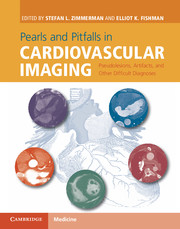 Pearls and Pitfalls in Cardiovascular Imaging
Pearls and Pitfalls in Cardiovascular Imaging Book contents
- Frontmatter
- Contents
- List of contributors
- Preface
- Section 1 Cardiac pseudotumors and other challenging diagnoses
- Section 2 Cardiac aneurysms and diverticula
- Section 3 Anatomic variants and congenital lesions
- Section 4 Coronary arteries
- Section 5 Pulmonary arteries
- Section 6 Cardiovascular MRI artifacts
- Section 7 Acute aorta and aortic aneurysms
- Case 54 Pitfalls in arterial enhancement timing
- Case 55 Misdiagnosis of acute aortic syndrome in the ascending aorta due to cardiac motion
- Case 56 Aortic pseudodissection from penetrating atherosclerotic ulcer
- Case 57 Ductus diverticulum mimicking ductus arteriosus aneurysm
- Case 58 Pericardial recess mimicking traumatic aortic injury
- Case 59 Neointimal calcifications mimicking displaced intimal calcifications on unenhanced CT
- Case 60 The value of non-contrast CT in vascular imaging
- Case 61 Shearing of branch arteries in intramural hematoma: a mimic of active extravasation
- Case 62 Imaging features of aortic aneurysm instability
- Case 63 Aortoenteric fistula
- Case 64 Infammatory aortic aneurysm
- Case 65 Incorrect aneurysm measurement due to aortic tortuosity
- Section 8 Post-operative aorta
- Section 9 Mesenteric vascular
- Section 10 Peripheral vascular
- Section 11 Veins
- Index
- References
Case 63 - Aortoenteric fistula
from Section 7 - Acute aorta and aortic aneurysms
Published online by Cambridge University Press: 05 June 2015
- Frontmatter
- Contents
- List of contributors
- Preface
- Section 1 Cardiac pseudotumors and other challenging diagnoses
- Section 2 Cardiac aneurysms and diverticula
- Section 3 Anatomic variants and congenital lesions
- Section 4 Coronary arteries
- Section 5 Pulmonary arteries
- Section 6 Cardiovascular MRI artifacts
- Section 7 Acute aorta and aortic aneurysms
- Case 54 Pitfalls in arterial enhancement timing
- Case 55 Misdiagnosis of acute aortic syndrome in the ascending aorta due to cardiac motion
- Case 56 Aortic pseudodissection from penetrating atherosclerotic ulcer
- Case 57 Ductus diverticulum mimicking ductus arteriosus aneurysm
- Case 58 Pericardial recess mimicking traumatic aortic injury
- Case 59 Neointimal calcifications mimicking displaced intimal calcifications on unenhanced CT
- Case 60 The value of non-contrast CT in vascular imaging
- Case 61 Shearing of branch arteries in intramural hematoma: a mimic of active extravasation
- Case 62 Imaging features of aortic aneurysm instability
- Case 63 Aortoenteric fistula
- Case 64 Infammatory aortic aneurysm
- Case 65 Incorrect aneurysm measurement due to aortic tortuosity
- Section 8 Post-operative aorta
- Section 9 Mesenteric vascular
- Section 10 Peripheral vascular
- Section 11 Veins
- Index
- References
Summary
Imaging description
The most important finding in an aortoenteric fistula is ectopic gas either within the aortic lumen or adjacent to the aorta (Figure 63.1). Direct extravasation of intravenous contrast from the aortic lumen into the adjacent bowel, or extension of enteric contrast from the bowel into the aorta are extraordinarily rare, but highly specific signs. A number of less specific findings can also be identified, including effacement of the fat plane between the aorta and adjacent bowel, focal bowel wall thickening adjacent to the aorta, periaortic soft tissue thickening and fluid, or intramural hematoma with an adjacent thickened loop of bowel.
Importance
Although aortoenteric fistulas are quite rare, the development of a fistula is incredibly life-threatening, with a mortality rate of almost 100% in the absence of treatment.
Typical clinical scenario
Aortoenteric fistulas can be divided into primary and secondary forms. The secondary form is the most common, occurring in the setting of prior aortic surgery or graft placement, while the primary form is rarer, occurring in patients without a history of prior surgery or intervention (Figure 63.2). While the classic clinical presentation of patients with an aortoenteric fistula has been described with the triad of abdominal pain, massive gastrointestinal hemorrhage, and a pulsatile abdominal mass, many patients demonstrate only vague abdominal pain on initial presentation. While nearly all patients will eventually experience gastrointestinal bleeding, this may not be apparent on initial presentation. Unfortunately, endoscopy is of limited value in the diagnosis of a fistula, and conventional angiography can often struggle to make the diagnosis in cases of intermittent bleeding through the fistula. Nuclear medicine tagged red blood cell (RBC) scans are limited by poor spatial resolution and a lack of specificity. As a result, the diagnosis is often ultimately dependent on CT. The treatment for aortoenteric fistulas has gradually moved away from surgical intervention, and toward the use of endovascular techniques.
- Type
- Chapter
- Information
- Pearls and Pitfalls in Cardiovascular ImagingPseudolesions, Artifacts, and Other Difficult Diagnoses, pp. 204 - 205Publisher: Cambridge University PressPrint publication year: 2015
